Trouble in the Gardens

Botanical gardens are places of great natural beauty meant to give people pleasure and calm their spirits. Still, these living visions of paradise are earthly creations that exist with us and the rest of the world's creatures and creations. Sometimes the mix of people, the outside world, and paradise can be explosive.
Flyovers
![French cartoon shows people crowded outside the Tuileries Garden wall in Paris to view the first balloon ascension of Jacques Charles and Marie-Noël Robert in 1783. Several people are climbing over the wall, including two women whose dresses are pulled up exposing their naked bottoms to spectators who stare at them instead of the balloon aloft in the background. Citation: (1783) Aux Amateurs De Physique. France Jardin Des Tuileries Paris, 1783. [Paris: Chez Friese Graveur, rue de Harlay, maison de Mr. Berthaud, ?] [Photograph] Retrieved from the Library of Congress, https://www.loc.gov/item/2002722392/.](images/trouble_drones_balloon_flight.jpg) February 2018: It’s been almost three hundred years since French mathematician and physicist, Jacques Charles made the first untethered flight in a hydrogen balloon. He later wrote, “All was glorious — a cloudless sky above, a most delicious view around . . . How great is our good fortune! I care not what may be the condition of the earth; it is the sky that is for me now.” His flight began from Tuileries Garden in Paris, the first royal garden open to all except beggars, "lackeys" and soldiers.
February 2018: It’s been almost three hundred years since French mathematician and physicist, Jacques Charles made the first untethered flight in a hydrogen balloon. He later wrote, “All was glorious — a cloudless sky above, a most delicious view around . . . How great is our good fortune! I care not what may be the condition of the earth; it is the sky that is for me now.” His flight began from Tuileries Garden in Paris, the first royal garden open to all except beggars, "lackeys" and soldiers.
That first balloon ride in 1783 over a beautiful garden foreshadows the low flying flights of camera-equipped drones over many botanical gardens. Drones do give the same “most delicious view” that would be impossible to see in any other way. When I last checked YouTube, over 151,000 videos had been posted by pilots flying drones over botanical gardens in all parts of the world.
![By Jacek Rużyczka [CC BY-SA 4.0 (https://creativecommons.org/licenses/by-sa/4.0)], via Wikimedia Commons](images/trouble_drones_drone_banned.jpg) Botanical gardens are taking note. Policies are being developed to control or quash flying drones over their grounds. The Chicago Botanical Garden has banned all drone photography over its grounds. Kew Gardens outside London does too: “Leave the flying to the birds – drones and other remotely controlled aircraft are not allowed.” The Royal Botanical Gardens in Hamilton, Ontario includes a vast nature sanctuary that’s home to a dense concentration of wild plants, birds, and animals. Banned drones have been spotted there trying to get close-ups of a nesting eagle and of a coyote feeding on a deer.
Botanical gardens are taking note. Policies are being developed to control or quash flying drones over their grounds. The Chicago Botanical Garden has banned all drone photography over its grounds. Kew Gardens outside London does too: “Leave the flying to the birds – drones and other remotely controlled aircraft are not allowed.” The Royal Botanical Gardens in Hamilton, Ontario includes a vast nature sanctuary that’s home to a dense concentration of wild plants, birds, and animals. Banned drones have been spotted there trying to get close-ups of a nesting eagle and of a coyote feeding on a deer.
Other gardens have banned drones because of danger to visitors and possible litigation. The Tower Hill Botanic Garden in central Massachusetts says the ban on drones is needed “to avoid or minimize injury to wildlife, visitors, staff, and neighbors; damage to property; disturbance to wildlife; negative reaction from visitors and neighbors concerned about personal safety or privacy, or simply annoyed by the sight and noise of a drone; and, potential exposure to legal action by a visitor injured by another party’s drone.”
Rather than issue an outright ban, other botanical gardens have put policies in place that regulate drone flights while raising money at the same time. The Missouri Botanical Garden, the garden where I usually walk, treats drone photography the same way it treats other commercial photography – fill out an application, get the garden’s approval, show proof that you have a liability insurance of $1,000,000 for any damage the drones may cause to plants, people, grounds, or buildings, and pay a fee of $100 - $300 a hour. At the Myriad Botanical Gardens in Oklahoma City drone pilots also need buy a permit to fly, but they are only allowed to fly their drones on the Garden’s large open lawn and only on certain mornings before the Garden opens to visitors. Friends invited to watch the drone flights are also charged a fee.
![By Don McCullough from Santa Rosa, CA, USA (Drone and Moon) [CC BY 2.0 (http://creativecommons.org/licenses/by/2.0)], via Wikimedia Commons](images/trouble_drone_in_flight.jpg) Beyond bans and rules there are technologies available to detect the sound and location of drones and then disable them. They are expensive and carry their own risks. Last year the National Science Foundation funded a three-year study to find affordable ways to locate unwanted drones and also to determine whether changes could be made in the landscape that would make drone flying less enticing. The study findings will have to skirt around a federal regulation that classifies drones as aircraft. So no matter what mischief a drone may do, as an aircraft it’s illegal to destroy or physically incapacitate the drone while it’s in flight above your property. The study is being done at Sarah P. Duke Gardens on the Duke University Campus.
Beyond bans and rules there are technologies available to detect the sound and location of drones and then disable them. They are expensive and carry their own risks. Last year the National Science Foundation funded a three-year study to find affordable ways to locate unwanted drones and also to determine whether changes could be made in the landscape that would make drone flying less enticing. The study findings will have to skirt around a federal regulation that classifies drones as aircraft. So no matter what mischief a drone may do, as an aircraft it’s illegal to destroy or physically incapacitate the drone while it’s in flight above your property. The study is being done at Sarah P. Duke Gardens on the Duke University Campus.
Despite bans, required permits, and payments, rogue drones continue to fly over public parks and botanical gardens. For example, the Arboretum and Botanical Garden in Dallas has a strict ban on all drone flights: “No drones are allowed on the Arboretum grounds under any circumstances.” Yet go to YouTube and you can watch at least a dozen videos of drone flights over the Garden. The appeal of sharing social media postings, a lack of awareness of policy the bother and cost of permits, the joy and excitement that comes with creating breath taking images, and even intentional maliciousness will keep the drones flying over botanical gardens -- at least until someone is injured or harmed.
A Tree Dies in Melbourne
January 2015: Senseless. That’s the word. It applies whenever I see harm done to anything – person, animal, plant, or thing - that seems to have no purpose or intent. Vandalism is the term meant to describe acts meant to destroy or spoil things that are beautiful or cherished. But what the word doesn’t convey is the feeling of revulsion and urge to seek retribution I feel against the destroyers.
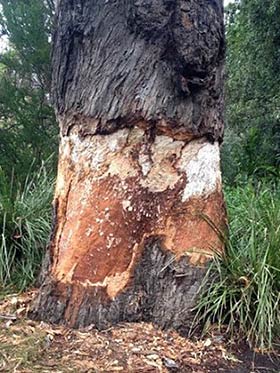 Botanical gardens as custodians of beautiful and venerable plants attract their share of vandals. The latest incident happened at Melborne’s Royal Botanic Gardens. The target was a 400-year red gum tree (Eucalyptus camaldulensis). While red gum trees are neither rare nor endangered in Australia, this particular red gum tree holds history and heritage under its canopy. It’s called the ‘Separation Tree’ because in 1850 people gathered under it to celebrate the news that Victoria had been granted permission to separate from New South Wales as a distinct colony with its own legislature and constitution.
Botanical gardens as custodians of beautiful and venerable plants attract their share of vandals. The latest incident happened at Melborne’s Royal Botanic Gardens. The target was a 400-year red gum tree (Eucalyptus camaldulensis). While red gum trees are neither rare nor endangered in Australia, this particular red gum tree holds history and heritage under its canopy. It’s called the ‘Separation Tree’ because in 1850 people gathered under it to celebrate the news that Victoria had been granted permission to separate from New South Wales as a distinct colony with its own legislature and constitution.
The old gum tree was attacked twice – once in 2010 and again in 2013. Both times the tree was ‘ringbarked’ with a chainsaw or an axe. Removal of the bark in a ring all around the trunk slowly kills a tree because it disrupts the tree’s ways of carrying nutrients up and down the down its trunk. Garden experts managed to patch the tree up as best they could for a few years, but now the tree has started to fade This month arborists at the garden have removed the tree's outer branches as the canopy begins to die.
Thieves in the Gardens
January 2015: The Signature of All Things, a new novel by Elizabeth Gilbert, begins with a story about Henry Whittaker, a young boy growing up in England in the 1770s. Henry learned about plants from his father who worked as an orchard man for Sir Joseph Banks, the superintendent of the gardens at Kew outside London. Banks was a renowned collector of rare and exotic plants, but he was notoriously stingy about sharing with other botanists or collectors. Henry saw an opportunity here. With his easy access to the garden and its collections, Henry began to take orders from Banks’ disgruntled and disappointed visitors and in return for a fare payment, he would filled those orders with plants, seeds, and cuttings that he stole from the gardens. Gilbert writes, “He worked all day with his father in the orchards, and stole all night – rare plants, precious plants, lady’s slippers, tropical orchids, carnivorous marvels from the New World.” Henry was in eyes of clients a “useful little fingerstink”.
Today, most thieves are still like Henry. They take plants from botanical gardens to sell them for profit. Others though take them just because they relish the exhilarating feeling of exclusivity that comes with owning something rare and unusual. Then too there are a few people who steal plants from a botanical garden because taking is cheaper than buying. Some just take because they want a souvenir.
![Nymphea Thermarum By C T Johansson (Own work) [CC BY-SA 3.0 (http://creativecommons.org/licenses/by-sa/3.0)], via Wikimedia Commons](images/trouble_thieves_waterlily_Nymphaea_thermarum.jpg) The most talked plant theft in 2014 happened at the Royal Botanic Gardens at Kew outside London. The loss was a tiny waterlily. The waterlily, Nymphaea Thermarum,
has white flowers not much larger than a fingertip. Typically pads are just two inches across. A Kew horticulturist figured out how to grow these exotic little things and even how to get them to bloom, but even so in unskilled hands they’re extraordinarily easy to kill.
The most talked plant theft in 2014 happened at the Royal Botanic Gardens at Kew outside London. The loss was a tiny waterlily. The waterlily, Nymphaea Thermarum,
has white flowers not much larger than a fingertip. Typically pads are just two inches across. A Kew horticulturist figured out how to grow these exotic little things and even how to get them to bloom, but even so in unskilled hands they’re extraordinarily easy to kill.
At the Abbotsbury Subtropical Garden on the south coast of England visitors are stealing less exotic plants. They’re hiding fold-up shovels, trowels, and scissors in their backpacks or handbags. Then when they find a plant they want, they dig it up, cut off its foliage and then make off with the root ball. Some of the plants being stolen such as Tasmanian Flax-lily (Dianella tasmanica) or the New Zealand Cabbage Palm (Cordyline australis), are not particularly rare or expensive to buy, but they do trigger plant lust in visitors startled at seeing subtropical plants thriving outdoors in England. "There seems to be a pattern. We put out new plants in spring and autumn and a few weeks later they’re gone,” said a gardener at Abbotsbury.
![Echinopsis pachanoi Cactus Forest & Kim Starr [CC BY 3.0 (http://creativecommons.org/licenses/by/3.0)], via Wikimedia Commons](images/trouble_thieves_cactus_Echinopsis_pachanoi.jpg) The Dundein Botanic Garden on South Island New Zealand reported a persistent problem with thieves breaking into their glasshouse to steal cactuses. In the most recent break-in in late 2014, thieves also stole the security camera meant to deter them from stealing. The thieves were looking for species such as the peyote cactus (Lophophora williamsii), the San Pedro cactus (Echinopsis pachanoi), and the Peruvian torch (Echinopsis peruviana) -- all of which can be used to produce psychedelic drugs.
The Dundein Botanic Garden on South Island New Zealand reported a persistent problem with thieves breaking into their glasshouse to steal cactuses. In the most recent break-in in late 2014, thieves also stole the security camera meant to deter them from stealing. The thieves were looking for species such as the peyote cactus (Lophophora williamsii), the San Pedro cactus (Echinopsis pachanoi), and the Peruvian torch (Echinopsis peruviana) -- all of which can be used to produce psychedelic drugs.
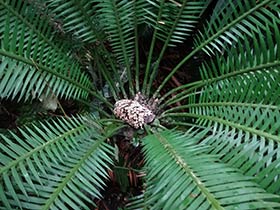 The most serious and damaging plant thefts are in botanical gardens that have cycad collections. Cycads look like giant prehistoric ferns with large woody trunks topped with a crown of large spiny divided leaves. They have neither flowers nor fruit but instead produce seeds or pollen inside jutting cones at the center of their crowns.
The most serious and damaging plant thefts are in botanical gardens that have cycad collections. Cycads look like giant prehistoric ferns with large woody trunks topped with a crown of large spiny divided leaves. They have neither flowers nor fruit but instead produce seeds or pollen inside jutting cones at the center of their crowns.
Cycads are being stolen from botanical gardens and are disappearing from the wild because they’re so valuable. A mature plant can bring from $5,000 to $10,000 and a few extremely rare varieties are being offered at $100,000 on the black market. Private collectors are willing to buy black market cycads because they feel they are investing in a one-of-a kind specimen that no one else can duplicate. Collectors also relish the cachet of antiquity that comes with owning a cycad – a plant that goes back at least 12 million years.
The Fairchild Botanic Garden, a botanical garden in Coral Gables, Florida, with a extensive cycad collection, had 40 cycads stolen from its Tropical Plant Conservatory and Rare Plant House in 2002 and 30 more during the aftermath of Hurricane Frances in 2004.
In South Africa, the Kirstenbosch National Botanical Garden in Cape Town has been the target of repeated attacks as well. Kirstenbosch has one of the largest collections of rare cycads anywhere in the world so it’s become the Tiffany of plant thieves. In 2014 alone thieves stole 24 cycads. Twenty-two of them were critically endangered species.
Things other than plants get stolen from botanical gardens too. Curators at the Abbotsbury Subtropical Garden say that the metal tombstone markers that identify plants with their common and botanical names often get stolen. Curators claim, “Labels don’t always last long in a public garden as some visitors find the label itself a rather convenient memento to take home as an aide-mémoire!”
Then there’s the art. Many botanical gardens have permanent pieces of sculpture installed on their garden grounds as well as art works from special exhibitions. Both are targets. The Denver Botanic reported three pieces of curly blown glass spikes called “Cat Tails” were stolen from a Chihuly exhibition in 2014. The spikes were part of a larger exhibit of dozens of other similar orange and black glass pieces. The stolen pieces were large, fragile, difficult to transport, and mounted to the ground. Gardens officials are still wondering how and why they were stolen since they’re just a small part of a larger display and because they’re too recognizable to sell.
Permanent art installations are also being stolen. At the Auckland Botanical Garden a bronze sculpture of an eel weighing nearly 200 pounds and bolted securely to an upright panel was taken by thieves in 2014. The thieves were caught when they tried to sell the $30,000 sculpture as junk at a local scrap yard for $300.
At the Botanical Garden in San Francisco a regular visitor to Garden classes and openings stole a pair of botanical paintings from the Garden’s library in 2010. He was caught after he was spotted making off with the paintings. After he was caught, 40 more art works were recovered from the hotel room where he lived.
Botanical Gardens are doing what they can to keep their plants and collections. Walls are being build around the gardens. Surveillance cameras are being installed. Security teams patrol the gardens. One garden is even posting signs near plants likely to be stolen asking visitors to report any suspicious activity they might see.
![Cycad Encephalartos wodii -- Purves, M. [GFDL (http://www.gnu.org/copyleft/fdl.html) or CC BY-SA 3.0 (http://creativecommons.org/licenses/by-sa/3.0)], via Wikimedia Commons](images/trouble_thieves_endanged_cycad.jpg) In a botanical gardens such as Kirstenbosch in Capetown, South Africa where rare and endangered plants are being stolen by organized groups of criminals, rewards are being offered and their precious Encephalartos woodii cycad has been surrounded by a wire cage. However, motion sensors, microchips and microdots have not stopped the poachers. Next to be tried are DNA signatures able to uniquely identity each plant.
In a botanical gardens such as Kirstenbosch in Capetown, South Africa where rare and endangered plants are being stolen by organized groups of criminals, rewards are being offered and their precious Encephalartos woodii cycad has been surrounded by a wire cage. However, motion sensors, microchips and microdots have not stopped the poachers. Next to be tried are DNA signatures able to uniquely identity each plant.
Perhaps the best solution to theft is take away a plant’s uniqueness. Making a plant common, easily and cheaply available drives away poachers and treasure hunters by removing the incentive to steal. At the Royal Botanical Garden at Kew where the tiny water lily was stolen, the plants are now being propagated and grown in large qualities to try to dampen their desirability.
Guns and Gardens?
![]() February 2016: The Georgia Supreme Court will decide whether people with gun permits have the right to carry weapons into the Atlanta Botanical Garden.
February 2016: The Georgia Supreme Court will decide whether people with gun permits have the right to carry weapons into the Atlanta Botanical Garden.
A Georgia gun law that went into effect in July 1, 2014 allows Georgians with weapon permits to openly carry weapons in public places such as churches, bars, schools, airports, and some government buildings.
The suit before the Supreme Court contends that Georgia law allows residents with permits to carry guns into public places and that the Garden is one of those public places. The suit reasons that since the Garden leases all of its land from the City of Atlanta that makes it a public space. Therefore it cannot ban firearms from its property. The Garden contends that the City has given it full control to regulate its property and as such it is private property and has the right to set and enforce its own policies.
The dispute started in October 2014 when a member of both a gun-rights advocacy organization and the Atlanta Botanical Garden visited the garden while openly carrying his permitted handgun in a holster on his waistband. Garden policy says that weapons of any kind are not prohibited on the grounds and the “Visitors who choose not to comply . . . may be asked to leave the Garden.” When garden staff saw the weapon they called the police and had the visitor escorted out of the Garden.
The Saga of the Wandering Flying Foxes
![Flying-fox Pteropus poliocephalus by Neville W. Cayley (1887-1950) [public domain]](images/trouble_flying_fox_illustration.jpg) June 2014 Update: They are called "flying foxes." With their reddish-brown markings and long snouts, this specie of Australian fruit bat resembles a fox. In colonies of tens of thousands they prefer to roost in eucalyptus forests. But as gum trees are cut for pasture and homes, the bats have headed to parks and orchards closer to cities and towns. There, the bats' fondness for fruit, their screeching voices, guano, and gregarious style of living have made them unwelcome for many.
June 2014 Update: They are called "flying foxes." With their reddish-brown markings and long snouts, this specie of Australian fruit bat resembles a fox. In colonies of tens of thousands they prefer to roost in eucalyptus forests. But as gum trees are cut for pasture and homes, the bats have headed to parks and orchards closer to cities and towns. There, the bats' fondness for fruit, their screeching voices, guano, and gregarious style of living have made them unwelcome for many.
Twenty years ago small numbers of grey-headed flying foxes settled in the Melbourne Botanical Garden in a area called Fern Gully. Fern Gully was started in the 1870s as a preserve for Australian rainforest trees and plants. Today, according to the Garden, "Fern Gully presents an interesting and valuable collection of rare and threatened plant species."
The colony of flying foxes in the Garden began to increase dramatically in the late 90s. By February 2001, there were 20,000 bats roosting in the tall trees of Fern Gully. "This is an unprecedented crisis," said Garden director Dr. Philip Moors. He said that because of the damage being done to rare and endangered trees and plants in Fern Gully and the failure of alternative ways used to control the population of flying foxes, he was authorizing culling of the bats. "I recognise this is going to upset some people. But there will also be many, many others who will say, 'It's about time. Get on with it.' The media and public will know threats have been made against the heritage and rare trees in the Gardens, including a threat to kill one tree for every bat culled. I think you will understand then why I do not intend to give a running commentary on the culling operation."
The reaction of animal activists was immediate. Flying Foxes were in danger of extinction themselves, they claimed. Further, they said that if the bats in the Garden were killed, others would return to fill their places leading to endless rounds of killing. The Humane Society for Animal Welfare held a protest in the gardens and began a protest vigil setting up tents and camping on the Garden grounds. Television and newspapers covered a noisy demonstration at 2 a.m. outside the home of Dr. Moors and later outside his office. Barbed wire was installed on the fences around the Garden and guard dogs were brought in. Protesters placed a dead bat on the steps of parliament building. HSWA members contacted the Garden board members and financial supporters to urge them to withdraw their support of the Garden. Police were called in to prevent violence. The Humane Society International tried unsuccessfully to get a court-ordered injunction to stop the shooting of flying foxes in the Garden.
As cooler weather finally arrived, about half of the colony left the Garden and the culling stopped. According to the Garden's website, an attractive alternative roosting site outside the garden had been located -- the Ivanhoe Public Golf Course and adjacent to the grounds of two private golf clubs.
By July of 2002 the new site was ready. Better roosting spots were made. Leaf litter from the Botanical Garden was brought collected to make the new residents feel at home, and a feast of tasty weed seedlings and ferns was planted. To jump start the intended migration, seventy bats were moved to the Ivanhoe site, fake bats were hung from the trees, bat guano was scattered under the trees, and bat treats were scattered around. The hope was that the bats would realize how much better Ivanhoe was than their old digs in the Botanical Garden and fly off to their designated new home.
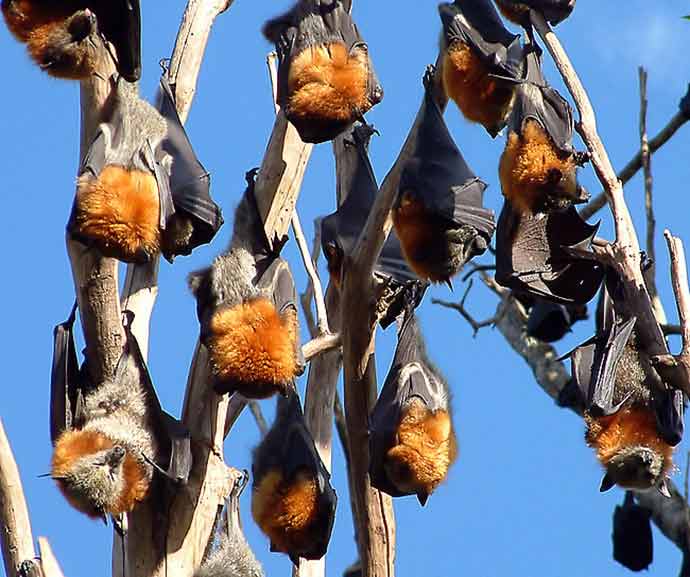 But the bats didn’t move. By March 2003 there were a record number of 28,300 animals still roosting in the Garden. The Garden had had enough of this voluntary relocation program and this time decided to encourage the bats to move out by banging on metal trash cans and clanging on cymbals from dusk to dawn.
But the bats didn’t move. By March 2003 there were a record number of 28,300 animals still roosting in the Garden. The Garden had had enough of this voluntary relocation program and this time decided to encourage the bats to move out by banging on metal trash cans and clanging on cymbals from dusk to dawn.
In April 2003, the bats moved. All of them. But none of them moved to their carefully planned and fully prepared new community at Ivanhoe. Instead the colony divided. About 500 flew to Geelong Botanic Garden, about forty miles away. But the rest stayed in the area moving into home gardens and backyards of quieter neighborhoods and into the Melbourne city parks, including Fitzroy Gardens, the City's premier public park.
City officials were not welcoming. For starters they said that the State's Department of Sustainability and Environment and the Melbourne Botanical Garden cooked up the relocation plan "without the City of Melbourne involvement." Now the City was stuck with 6000 flying foxes in Fitzroy Gardens. The animals they claimed were damaging the heritage elms and keeping visitors away because of "their noise, unpleasant smell and droppings." Something had be done and soon because "in August many animals are expected to migrate back from eastern Australia and roosting numbers are expected to increase. Also breeding is expected to commence at this time, and disturbance activities will have to cease due to animal welfare concerns."
The Botanical Garden and State's Department of Sustainability and Environment stepped in and started a new "dispersal effort" at Fitzroy Gardens bringing with them their arsenal of recorded noises, clanging cans and cymbals, starting pistols and even the sounds of fireworks. At dusk and dawn every day for a month between June and July 2003, it was the din versus the bats. At its August 2003 meeting, the Melbourne City Council announced with some relief that the din had worked. The flying foxes had left Fitzroy Gardens.
By September 2003, the colony of bats had settled on a new home. Again they ignored Ivanhoe and instead picked Yarra Bend Park in suburban Melbourne's exclusive Kew neighborhood. Again, local officials said the bats had to go. They were carriers of harmful diseases, the mayor said. And anyway promises were made that they would reside in Ivanoe, a site well outside Kew's neighborhood. A Kew homeowner complained "The flying foxes are tormenting the residents . . . screeching for hours before dawn every day, disturbing our sleep and polluting the air with their stench. We are worried about risks to our physical health from their excrement . . . and our mental health from their torment."
A government spokesperson thought differently. The government had already spent A$300,000 unsuccessfully trying to lure the bats to a new home at Ivanhoe. Even though the bats didn’t go the Ivanhoe as planned, he felt the relocation of the colony in Kew had been a "fantastic success." "Further attempts to relocate the colony could result in its dispersal to nearby residential areas or back into inner-city parks and gardens." To placate residents and park goers the government promised to spend A$1.7 million on new plantings and weed control, as well as the constructing roosting structures, viewing platforms and footpaths.
The bats liked the improvements, the quiet, and the tony address. So they stayed. Now in 2014 there are about 30,000 of them living in Yara Bend Park where they have become an important tourist attraction. And from strong opposition a decade ago, the City now says that “Flying foxes are beneficial to bushland regeneration as they pollinate plants and disperse native seed . . .[they] now have limited habitat available and sharing ours with them can be inconvenient, but if we understand and respect their plight, it may make it easier for us to appreciate them and tolerate any inconveniences.”
[Note: Since I started writing this piece in 2002, many of the hyperlinked sources have disappeared from the internet, so while I have continued to hyperlink my original sources, some of the links will no longer work.]
Ashes in the Gardens: To Ban or Not to Ban?
![alters Art Museum [Public domain, CC-BY-SA-3.0 (http://creativecommons.org/licenses/by-sa/3.0) or GFDL (http://www.gnu.org/copyleft/fdl.html)], via Wikimedia Commons](images/trouble_urn.jpg) Written 2002 and updated October 2014: A couple can be married in the the botanical garden where I walk for $1200. For a fee, the Garden will also welcome all kinds of private parties and corporate events to its grounds. However, not listed on the rate card I picked up are fees for events honoring loved ones by scattering their ashes in some favorite spot in the Garden. I had never even thought about the possibility of scattering cremains in a botanical gardens until I read about an incident that happened at Melbourne’s Royal Botanic Gardens in 2000.
Written 2002 and updated October 2014: A couple can be married in the the botanical garden where I walk for $1200. For a fee, the Garden will also welcome all kinds of private parties and corporate events to its grounds. However, not listed on the rate card I picked up are fees for events honoring loved ones by scattering their ashes in some favorite spot in the Garden. I had never even thought about the possibility of scattering cremains in a botanical gardens until I read about an incident that happened at Melbourne’s Royal Botanic Gardens in 2000.
Anglican priest Peter Macleod-Miller said he had often officiated at memorial services where ashes were scattered in the Garden. The ceremonies were held without incident and relatives had never been charged a fee. Sometime later Father Macleod-Miller learned that one of his parishioners had been asked to pay a fee of $500 to scatter the ashes of a loved one in the Garden. Father Peter was outraged calling the charges a rip-off and a scam.
Family and friends agreed to pay the fee and the ceremony went on a scheduled. Fr. Peter grumbled that an employee of the Garden attended the memorial to collect the money as soon as the service was over. He also complained that his solemn words of remembrance had been drowned out by nearby lawn mowers.
The director of the Garden, Dr. Philip Moors, explained that the scatter charge was meant to discourage families from considering the Garden as the final resting place of their loved ones. He acknowledged that many people have great affection for the Gardens, but that the Garden was a place of relaxation and celebration for the living, not a memorial garden for the dead. Further he said, "How would you feel in your back garden if there were a total stranger's ashes being sprinkled in an area that you're working on? ... It's entirely understandable that they [the garden staff] should have reservations about human remains under the rosebush, as it were. We believe our policy is based on common sense and the provision of proper care for the gardens."
Since the incident, The Melbourne Royal Botanic Gardens returned the $500 fee to the family, but has completely banned the scattering of ashes in the Gardens.
Instead of scattering ashes, the Garden is now encouraging families who “wish to pay tribute to a loved one who has enjoyed spending time in our beautiful Gardens” to place a plaque on a bench. ‘Sponsoring’ a bench costs A$7,000 and must be renewed every ten years.
Some other botanical gardens have followed Melbourne’s policy of banning ashes, but encouraging contributions. The Botanic Garden in Sydney
also prohibits scattering or burying ashes because their gardens are “places of celebration, reflection and peace . . . for all people.” And like Melbourne, Sydney encourages donors to remember their loved ones with a plaque on a bench (A$10,000) or on a tree (A$10,000), again renewable every ten years. In keeping with the ideal of a Garden as a place of celebration, plaques that include birth and death dates, words like the terms ‘in memory’, ‘in tribute’ and ‘dedicated to’ cannot be used. ‘In celebration of’ is permissible though.
Some Gardens have decided that ashes and contributions can co-exist. At the Dawes Arboretum in Newark, Ohio, ashes can be scattered in some favorite place in the garden or under an especially loved tree. Here the policy seems to accept human nature -- regulations won’t stop some people from doing what they feel them want to do or must do -- so why not let them feel good about what they’re doing and have the Garden reap some benefit. So for $5,000 family members can scatter ashes in a spot of their choice and have their loved ones remembered on a plaque (for ten years, of course).
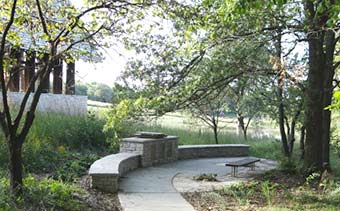 Powell Botanical Gardens outside Kansas City, Missouri goes even further in allowing the beauty of its gardens to be shared with cemains of visitors past. They have designated a secluded part of the 900-acre botanical garden to be used as a scatter garden. Called the Memorial Garden, it’s located in a less visited part of the garden planted with wildflowers and native trees along a path that overlooks a lake. The garden features a memorial wall that includes the names of those whose cremains are in the garden. A donation of $3,000 includes authorization to scatter ashes, permission to hold a gathering of remembrance, and placement of a plaque on the memorial wall.
Powell Botanical Gardens outside Kansas City, Missouri goes even further in allowing the beauty of its gardens to be shared with cemains of visitors past. They have designated a secluded part of the 900-acre botanical garden to be used as a scatter garden. Called the Memorial Garden, it’s located in a less visited part of the garden planted with wildflowers and native trees along a path that overlooks a lake. The garden features a memorial wall that includes the names of those whose cremains are in the garden. A donation of $3,000 includes authorization to scatter ashes, permission to hold a gathering of remembrance, and placement of a plaque on the memorial wall.
A River and a Botanical Garden Both Change
Written in 2001; Updated December 2014: In the late 90s a tipster reported The New York Botanical Garden to the State Attorney General's Office for dumping pollutants into the Bronx River. An investigation by the Attorney General's Office and the New York Department of Environmental Conservation claimed that the Garden was violating state and federal environmental laws by illegally discharging as much as 5,000 gallons a day of pollutants into the Bronx River, New York's only freshwater river. The suit charged that pollutants such as pesticides, fertilizers, and oil came from the Garden's greenhouses and were being dumped storm drains that emptied directly into the Bronx River. A mile of the river runs through the Garden.
While the Garden the denied amount of dumping and the nature of the water discharged into the river, it did agree to an out-of-court settlement in January 2002. The terms of settlement required the Garden to stop the discharges and to collect its wastewater in storage tanks for proper disposal. The Garden also agreed to spend $365,000 on projects meant to benefit the river and the people who use it. One of the projects includes building a canoe launch and canoe portage trail on the Garden grounds.
Much has happened since. In 2001 a new coalition of activists, environmentalists, and community groups banded together to form an organization called the Bronx River Alliance. The group was formed to “act as a coordinated voice for the river” by working with public and private partners “to protect, improve, and restore the Bronx River corridor and greenway so that they can be healthy ecological, recreational, educational, and economic resources for the Bronx communities through which the river flows.”
Since that beginning, the Alliance and its partners and volunteers worked to create 10 acres of parkland along the river, developed a greenway of trails along the river, sponsored canoeing trips along the river, encouraged schools to help children learn about the river, planted thousands of trees along the river, pulled hundreds of tons of garbage, old cars, tires, and appliances out of the river, and reintroduced native fish and wildlife to area. Water quality remains a problem. According to the Alliance “while the Bronx River is generally clean enough for canoeing and other activities with minimal water contact, today the river is too polluted for swimming.”
In summing up developments along the river in the past ten years, a reporter from the New York Times wrote, “Progress is painfully slow. Still, what’s happened, under the circumstances, is hardly short of miraculous.
Since the 2002 settlement, the New York Botanical Garden has become an active supporter and partner of the Alliance serving on its Board of Directors and adding scientists to its river monitoring committees.
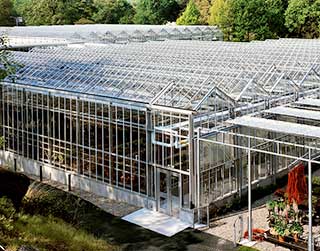 To benefit both the river and the Garden, the Garden built a new $25 million state-of-the-art complex of greenhouses that puts nearly an acre of growing space under glass. Important to the health of the river, the new greenhouse includes its own water treatment facility to manage fertilizer and pesticide disposal as well as machines that purify and recycle nearly 2,000 gallons of greenhouse water every day.
To benefit both the river and the Garden, the Garden built a new $25 million state-of-the-art complex of greenhouses that puts nearly an acre of growing space under glass. Important to the health of the river, the new greenhouse includes its own water treatment facility to manage fertilizer and pesticide disposal as well as machines that purify and recycle nearly 2,000 gallons of greenhouse water every day.
![By Jim.henderson (Own work) [CC0], via Wikimedia Commons Public domain](images/trouble_NYBG_BronxRiver.jpg) Along the river, visitors to the Botanical Garden can now launch kayaks from a site inside the Garden. However, the biggest improvement along the river banks has been the restoration of 50-acres forest and walking trails that line the river. The Thain Family Forest as it is now called is the largest uncut expanse of New York’s original wooded landscape. To bring it back what it might have been, the Garden removed hundreds of invasive species and replanted native species such as oaks, tulip trees, sweet gums, and spicebushes.
Along the river, visitors to the Botanical Garden can now launch kayaks from a site inside the Garden. However, the biggest improvement along the river banks has been the restoration of 50-acres forest and walking trails that line the river. The Thain Family Forest as it is now called is the largest uncut expanse of New York’s original wooded landscape. To bring it back what it might have been, the Garden removed hundreds of invasive species and replanted native species such as oaks, tulip trees, sweet gums, and spicebushes.
All these changes from a small lawsuit that was settled out of court? Likely not. The times and the sensibilities and the needs of the Garden and community are probably what mattered. Nevertheless, the river, the Bronx and the Garden have all benefited from what happened in 2001.
Beauty Needs Permission to Travel
 Written in August 2002 and revised December 2014: Six federal agents staged a predawn raid at the home of Mike Kovach in rural Virginia. They were looking for an orchid.
Written in August 2002 and revised December 2014: Six federal agents staged a predawn raid at the home of Mike Kovach in rural Virginia. They were looking for an orchid.
A year earlier on a trip to Peru, Kovach spotted an orchid at a roadside stand that was unlike any he had seen before. It was a ladyslipper orchid. But its bloom was twice the size of other ladyslippers, and instead of sporting a drab green or moss-colored flower, this orchid had colors that ranged from bright magenta to royal purple. As an orchid grower, Kovach knew he had found something new and unusual. ''We stumbled onto the Holy Grail of the orchid world,'' he later said to a Miami Herald reporter.
As the story was reported in the Miami Herald, Kovach asked the vendor to show him where he found the orchid. The vendor led him to a small colony of the unusual orchids growing on a cliff near the road. Noting the spot, Kovach returned to Peru the following spring. He found far fewer plants than he did a year ago. Word of the new orchid had spread in Peru and rumors on chat lines reported that the new orchids were fetching $10,000 a plant in South Florida.
 Kovach acted. He brought an orchid plant back with him to the United States and took it to the Marie Selby Botanical Gardens in Sarasota for identification in June 2002. Jovanovich chose Selby because the Gardens have more orchid taxonomists than any other botanical garden in the world. After examining the specimen, the curator of the Gardens' Orchid Identification Center declared, "This has got to be one of the most important plant discoveries for Selby Gardens and for the entire orchid world in the past 100 years." Selby named the new species of orchid Phragmipedium kovachii in honor of Mike Kovach. A week later, the Gardens published a claim to the name in their professional journal.
Kovach acted. He brought an orchid plant back with him to the United States and took it to the Marie Selby Botanical Gardens in Sarasota for identification in June 2002. Jovanovich chose Selby because the Gardens have more orchid taxonomists than any other botanical garden in the world. After examining the specimen, the curator of the Gardens' Orchid Identification Center declared, "This has got to be one of the most important plant discoveries for Selby Gardens and for the entire orchid world in the past 100 years." Selby named the new species of orchid Phragmipedium kovachii in honor of Mike Kovach. A week later, the Gardens published a claim to the name in their professional journal.
Now the story gets interesting. Coincidentally, Dr. Eric Christenson, an orchid taxonomist who used to work for the Selby Botanical Gardens, had detailed photographs of the new orchid that he received from colleagues in Peru. He too recognized the orchid as a new species and was finishing his own article on the plant for publication in the July 2002 journal of the American Orchid Society. Dr. Christenson would name the new species Phragmipedium peruvianum. Too late though. Scientific protocol dictates that the person or institution that first publishes a written description gets the naming rights. Selby beat Christenson by five days.
Christenson was incensed. He was quoted in the Miami Herald article as saying "...a rogue institution involved in an illegal act."
Peruvian officials complained too. They charged that the Selby Botanical Gardens had no right to give an official name to an illegally obtained plant. They also demanded that the U.S. government seize any of the orchids found in the United States and that the U.S. Fish and Wildlife Service open an investigation immediately.
The U.S. Fish and Wildlife Service enforces The Convention on International Trade in Endangered Species of Wild Fauna and Flora (CITES), an international agreement that among many other things prohibits people from importing or exporting ladyslipper orchids from their natural habitat.
In the investigation that ensued, Kovach's house and greenhouse were searched. Records of the Selby Botanical Gardens were checked; the Garden was searched; and a piece of the orchid taken from the Garden by an employee was confiscated. Grand Jury subpoenas were issued to a dozen Selby employees and board members.
Since the scandal broke, the executive director of the Garden and eight board members resigned. Garden supporters withheld nearly $500,000 in pledges.
St. Petersburg Times reporter Craig Pittman who had followed the story from its beginning, wrote: "As the yearlong investigation draws to a close, Selby is likely to be charged with violating laws designed to protect endangered plants from poachers. Selby's staff believes prosecutors will make an example of them to placate Peru, said Selby's crisis management consultant, Jeffrey Tucker. A criminal conviction could bring large fines and the loss of hundreds of thousands of dollars in grant money. Individuals could even face jail time. Attorneys' fees already are squeezing the garden's $3.2-million budget."
Dr. Eric Christenson, the rival orchid namer, said that he was not surprised. "These people are idiots," he said. "Everyone involved knew it was illegal."
In mid-December 2003, the Department of Justice filed criminal charges against the Selby Botanical Gardens and Wesley Higgins, head of their orchid identification center, for violating the Endangered Species Act. The maximum penalty for this offense is a one-year imprisonment and/or a $100,000 fine. "The Justice Department takes seriously any breach of conservation laws committed by businesses and individuals privileged to deal with endangered and threatened species," said Tom Sansonetti, Assistant Attorney General for the Justice Department's Environment and Natural Resources Division.
Rather than go to trial, the Gardens and Higgins pleaded guilty and worked out a settlement with the government. As reported in the Sarasota Herald Tribune, the Gardens was fined $5000 and will be placed on probation for three years. Higgins was fined $2000 and sentenced to two years on probation. The Gardens also agreed to apologize to members of the American Orchid Society and to ask the international orchid-naming society in Vienna, Austria to change the name of the orchid. Barbara Hansen, chair of Selby's board of trustees, said "We don't think it should be named for someone who illegally obtained it."
A month before charges were brought against Selby Gardens, Kovach was indicted for smuggling and possessing an endangered species. If convicted of smuggling, Kovach could face up to five years in prison and fines of up to $250,000. The possession charge could result in an additional year in jail and a fine of $100,000.
In June 2004 Kovach pleaded guilty to two misdemeanors: illegal possession of an endangered species and trade in an illegal commodity. He was tried in a U.S. District Court in November 2004 where he was found guilty and sentenced to two years of probation and fined $1,000. At the sentencing, the judge told Kovach that he narrowly escaped prison: "I'm resolving some doubts in your favor owing to your status as a first offender, but some of your explanations here are very nearly, "The dog ate my homework."
As to the orchid's fate: the editor of Orchid Digest went to Peru to find out. He reported that the original colony was stripped clean, however he did see 1,000 more plants growing on a remote cliff in the Andes.
So in order to preserve the remaining orchids, the Peruvian government allowed an orchid nursery grower from Lima to legally collect five plants to be used strictly for propagation. The government’s intention was to make illegal harvesting unprofitable by making the orchid widely available through regular commercial sales. More than a decade after the first plants were legally collected for propagation, buyers can readily purchase young plants, adult sizes, and hybrids of Phragmipedium kovachii orchids.
The Peruvian government still considers all kovachi orchids to be government property and as such the plants are not allowed to be sold or to leave Peru. Neither can artificially propagated divisions or even pollen from the flowers. All breeding also must be approved by the Peruvian government.
[Note: Since I wrote this piece in 2002, many of the hyperlinked sources have disappeared from the internet, so while I have continued to hyperlink my original sources, some of the links will no longer work.]
Copters in the Garden
Written in 2006 and revised in December 2014: The Bogor Botanic Garden is Indonesia’s premier botanical garden. The Garden is located in Bogor, a city of 300,000 about 35 miles south of the capital, Jakarta. Its 217 acres are in the heart of the city and adjoin the Presidential Palace and deer park of some 600 white-spotted miniature deer. Bogor Botanic Garden opened in 1817, a few years before there were any botanical gardens in the United States. On the Garden’s grounds of expansive lawns, avenues, and streams, and lotus ponds are more than 15,000 species of trees and palms and 3,000 varieties of orchids.
In early November of 2006, heavy equipment moved into the Bogor Botanic Garden and began excavating part of the lawn about 150 feet from the lily pond downhill from the Garden’s plant conservation center. Several days before the equipment arrived, Indonesian Air Force helicopters practiced landings and take-offs from the lawn. The reason? Two helipads were being built in the Botanic Garden to receive a copter that would carry President George Bush to the Garden for a brief meeting with Indonesian President Susilo Bambang Yudhoyono at the Presidential Palace on November 20th. Each helipad was to be 60 by 60 feet square. They were to be made of reinforced concrete strong enough to support Marine One, the eight-ton helicopter that would carry President Bush and his party.
When the director of the botanical garden first heard of the plan to build the helipads in the middle of the Garden, he said no. Aside from not wanting to pave part of the historic garden, he said he feared that wind generated by the chopper would damage the garden's trees, plants, and orchids. Especially vulnerable was the endangered 37-year-old female coconut palm from Maldives (Lodoicea Maldavica) near the helipads. It would be fruiting at the time the visit was scheduled. However, once construction work actually began, the director’s only comment was that he would "carry out the task."
Another source when asked why the helipads could not be built in or close to the Presidential Palace explained that the noise of the chopper would stress the nearby deer herd. So rather than upset the deer, the open space in the Garden’s conservation area would be used instead.
Indonesian’s opposition party said that using the gardens as a landing pad for helicopters would hurt the fragile environment, and that building a helipad in a botanic garden “means the (Indonesian) president is sacrificing environmental conservation for the sake of political interests."
Despite the protests, the helipads were built. A few days before President Bush was scheduled to arrive, the U.S. Navy tested the pads by landing some helicopters like those that would carry President Bush to the Botanic Garden.
 Ironically, when President Bush arrived in Bogor during a heavy rainstorm, his helicopter landed at a nearby sports stadium instead of at the carefully prepared helipads in the Botanic Garden. Then from the stadium, President Bush and First Lady Laura Bush traveled in an unmarked car to the Presidential Palace where they were greeted by President Susilo Bambang and First Lady Herawati Yudhoyono.
Ironically, when President Bush arrived in Bogor during a heavy rainstorm, his helicopter landed at a nearby sports stadium instead of at the carefully prepared helipads in the Botanic Garden. Then from the stadium, President Bush and First Lady Laura Bush traveled in an unmarked car to the Presidential Palace where they were greeted by President Susilo Bambang and First Lady Herawati Yudhoyono.
After President Bush left, the Botanic Garden dismantled the heliports because they “do not conform with the landscape of Bogor Botanic Gardens.”
As for the Lodoicea maldivica (coco-de-mer) coconuts, they were individually wrapped to keep them from banging together from the rotor wind. The fruit survived and the tree continued to develop more female flowers and more fruit.
 An aside: there’s a coco-de-mer coconut palm growing inside the tropical greenhouse of the Missouri Botanical Garden, the botanical garden where I usually walk. The tree was planted there in 1982 and while it doesn't produce coconuts, it does sprout giant leaves that dwarf all the other plantings in the tropical greenhouse.
An aside: there’s a coco-de-mer coconut palm growing inside the tropical greenhouse of the Missouri Botanical Garden, the botanical garden where I usually walk. The tree was planted there in 1982 and while it doesn't produce coconuts, it does sprout giant leaves that dwarf all the other plantings in the tropical greenhouse.
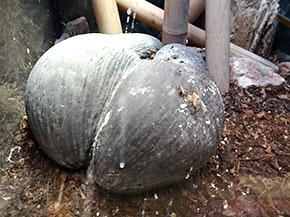
The coco-de-mer also has the largest known seeds in the world. They typically weigh in at 45 - 50 pounds per seed. The seeds, called a double coconuts, look like two coconuts fused together. A seed from the coco-de-mer is on display on the floor of the gecko tank in the annex to the greenhouse -- a good spot because geckos are known pollinators of coco-de-mer palms.
[Note: Since I wrote this piece in 2006, some of the hyperlinked sources have disappeared from the internet, so while I have continued to hyperlink my original sources, some of the links will no longer work.]
Good Neighbors Again
![]() Written in 2002 and revised in December 2014: Fordham University and the New York Botanical Garden are neighbors. They have faced one another across a street in the Bronx for over a hundred years. For nearly a decade years though, these long-time neighbors have been squabbling over a radio-transmitting tower
Written in 2002 and revised in December 2014: Fordham University and the New York Botanical Garden are neighbors. They have faced one another across a street in the Bronx for over a hundred years. For nearly a decade years though, these long-time neighbors have been squabbling over a radio-transmitting tower
Fordham houses public radio station WFUV-FM on its campus. The dispute with the Garden began in 1994 when the station began building a new transmission tower on the Western edge of its campus about 150 feet from the Garden. The tower rose to 260 feet of its proposed 480-foot height before the Garden convinced the New York City Buildings Department and the FCC to order construction stopped.
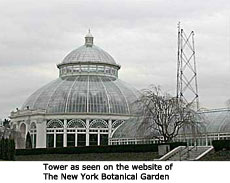 On its 2001 web page the Garden said that the "derrick-like tower looms over much of the Garden, diminishing its beauty and undermining the experience of its visitors." It believes that its Enid A. Haupt Conservatory is especially compromised. The Haupt Conservatory is a Victorian-era glass house that houses the Garden's tropical and desert plant collections. Used as a symbol of the Garden, the Haupt Conservatory was designated as a Landmark Building in 1973. The Garden considers its objections to the tower as a significant test case for determining whether landmark buildings and landscapes can be protected from nearby structures considered intrusive.
On its 2001 web page the Garden said that the "derrick-like tower looms over much of the Garden, diminishing its beauty and undermining the experience of its visitors." It believes that its Enid A. Haupt Conservatory is especially compromised. The Haupt Conservatory is a Victorian-era glass house that houses the Garden's tropical and desert plant collections. Used as a symbol of the Garden, the Haupt Conservatory was designated as a Landmark Building in 1973. The Garden considers its objections to the tower as a significant test case for determining whether landmark buildings and landscapes can be protected from nearby structures considered intrusive.
 Fordham University has another view. On its website WFUV-FM says it needs a new tower and the FCC agrees. The FCC approved construction of a new tower in 1983, and since then Fordham has looked at 30 possibilities. Any new site must be tall enough to dissipate excessive RF radiation. The radio signal sent out can't interfere with other radio stations nor can it garble tower-aircraft talk along the flight path to La Guardia Airport. The tower has to be in a secure location, and the University is committed to putting it in a place where it "would have the least impact on residential neighborhoods." The University believes that the only place that fits the bill is the place where the unfinished tower now stands.
Fordham University has another view. On its website WFUV-FM says it needs a new tower and the FCC agrees. The FCC approved construction of a new tower in 1983, and since then Fordham has looked at 30 possibilities. Any new site must be tall enough to dissipate excessive RF radiation. The radio signal sent out can't interfere with other radio stations nor can it garble tower-aircraft talk along the flight path to La Guardia Airport. The tower has to be in a secure location, and the University is committed to putting it in a place where it "would have the least impact on residential neighborhoods." The University believes that the only place that fits the bill is the place where the unfinished tower now stands.
Both the Garden and the radio station have been waging legal battles and public relation campaigns to win supporters. Both have web sites that state their views and discount the agreements of their neighbor; both are gathering names on online petitions; both are relying on celebrities to state their respective cases. WFUV even has a slogan: "No Tower. No Tunes."
Resolution of the dispute would be easy if this was an old-fashioned Western with good guy squared off against bad guy. But it's harder to take sides between a public radio station known for its programs that according to a Newsday article "help foster ethnic identity and cultural pride in a remarkable mix of communities" in the Bronx and a century-old, world-renowned botanical garden.
The Garden and the University have talking and looking for an alternative site that would satisfy them both. Finally, in May 2004, ten years after the stub of a tower was built, a tentative accord was reached when Montefiore Medical Center in the Bronx agreed to allow Fordham University to build a 142-foot tall transmission tower atop an apartment building that the hospital owned. Under terms of the agreement, the half-built tower on the campus of Fordham would be come down. The New York Botanical Garden, the Fordham University, and Montefiore Medical Center would share the cost of demolition and relocation.
The agreement held. In 2005 WFUV-FM got a new 142 foot high mast atop a 28 story apartment building located in one of the highest spots in the city. Then in May 2006 the New York Botanical Garden got its scenic view back when the half-finished tower came down.
